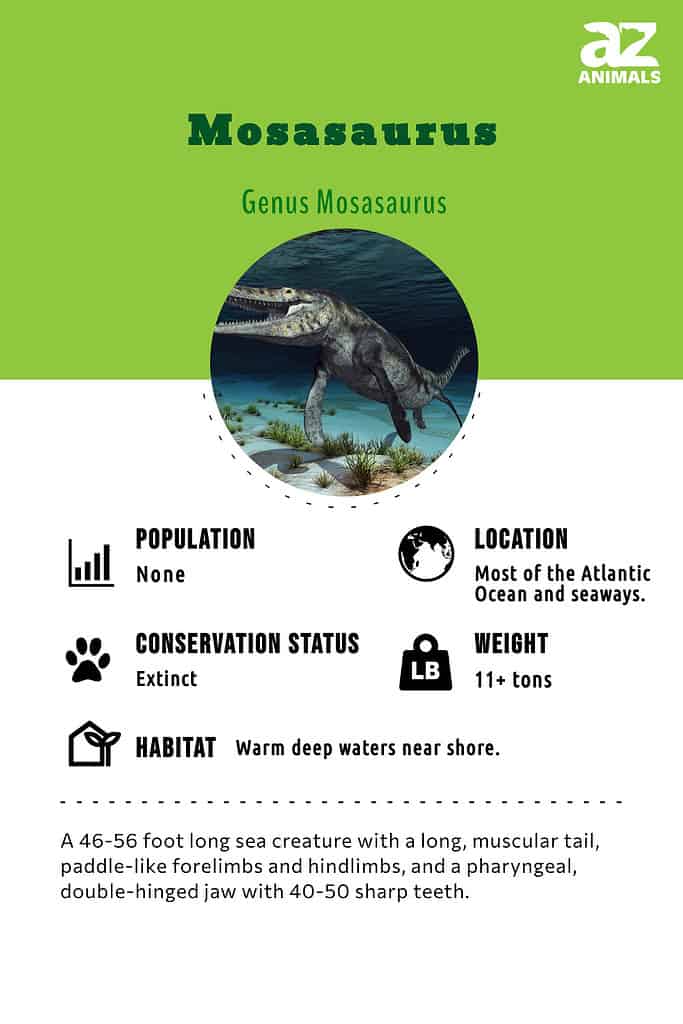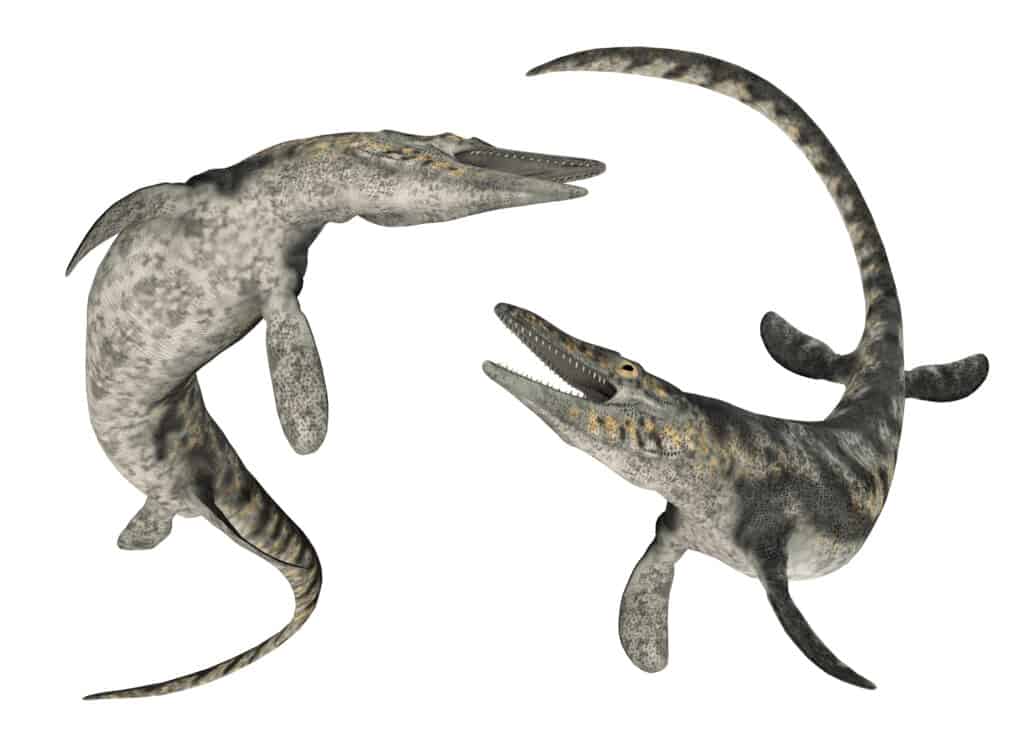Mosasaurus
Mosasaurus hoffmannii
The Mosasaurus was much longer than the fearsome Tyrannosaur rex.
Advertisement
Mosasaurus Scientific Classification
- Kingdom
- Animalia
- Phylum
- Chordata
- Class
- Reptilia
- Order
- Squamata
- Family
- Mosasauridae
- Genus
- Mosasaurus
- Scientific Name
- Mosasaurus hoffmannii
Read our Complete Guide to Classification of Animals.
Mosasaurus Conservation Status
Mosasaurus Facts
- Prey
- bony fish, cephalopods, sharks, marine reptiles
- Main Prey
- sea turtles
- Group Behavior
- Solitary
- Fun Fact
- The Mosasaurus was much longer than the fearsome Tyrannosaur rex.
- Estimated Population Size
- unknown
- Biggest Threat
- natural disasters
- Most Distinctive Feature
- double-hinged jaw
- Distinctive Feature
- long, muscilar tail
- Other Name(s)
- great animal of Maastricht
- Habitat
- shorelines, lagoons, shallow coastal waters
- Diet
- Carnivore
- Lifestyle
- Nocturnal
- Number Of Species
- 5
- Location
- Atlantic ocean
- Migratory
- 1
View all of the Mosasaurus images!
When people talk about prehistoric monsters, they typically refer to dinosaurs and other beasts that ruled the lands. But life in the Mesozoic was brutal on land and the seas. Among the ancient beasts that ruled the oceans of the world years ago was the Mosasaurus. It’s a genus of massive, aquatic, carnivorous lizards that lived during the Late Cretaceous Era from about 70-66 million years ago.

©
Scientific Name and Classification
The name Mosasaurus means “lizard of the Meuse River,” a reference to the river where a fossil was first found. It is a member of the Class Reptilia, Order Squamata, Superfamily Mosasauroidea (extinct), Family Mosasauridae (extinct), and Tribe Mosasaurini (extinct). There are dozens of genera in the Family Mosasauridae, and all these large marine reptiles are known as mosasaurs.
The Mosasaurus hoffmannii is the type species of this genus, which means most of the biological description are based on it. Other species include: M. missouriensis, M. conodon, M. lemonnieri, and M. beaugei. The possibility of one more mosasaur species is under investigation.
Description and Size

Mosasauruses had long and muscular tails that allowed them to
swim fast
and ambush prey.
©iStock.com/MR1805
Although they lived around the same time as the dinosaurs, the Mosasaurus was actually not a sea dinosaurs. Rather, it was a genus of reptiles more closely related to present-day squamate reptiles such as snakes and lizards.
Most species of the Mosasaurus genus were massive in size. In fact, the largest reptiles of the Mosasaur family were members of this genus. Mosasaurus hoffmanni is the biggest Mosasaur fossil ever found. Scientists estimate that it was about 39-42 feet long, but could get up to 57 feet! It weighed 2200 lbs. or more. Its size is comparable to that of the Megalodon, a well-known, giant prehistoric shark believed to have lived about the same time.
Although Mosasauruses were reptiles, they were similar in appearance to modern-day whales. They had a two-lobed tail made of soft tissue. The Mosasaurus’ tail bent slightly downwards towards the end. It also had a pair of forelimbs and hindlimbs. It used these paddle-like limbs for fast swimming.
The Mosasaurus had a massive head with pharyngeal jaws. The large jaws had 40-50 massive teeth that were long and sharp, with two opposite cutting edges. The jaw of the Mosasaurus was double-hinged, which allowed it to open its mouth wide to swallow prey whole.
Diet
Mosasaurus were most likely the most dominant predator species that lived during the cretaceous period. These large and carnivorous sea monsters would have eaten pretty much any kind of prey they could find, given their large size. Their diet would have consisted if ammonoids (extinct crustaceans), large fish, cuttlefish, sharks, sea birds, and even small mosasaurs. The Mosasaurus’s feeding habits differed from that of other sea predators. Instead of taking large bites out of prey like sharks, this reptile most likely swallowed its prey whole after piercing it with its massive teeth.
Habitat

Adult Tylosaurus, a mosasaur, grew to over 14 meters long, making it the largest marine
reptile
.
©Esteban De Armas/Shutterstock.com
Although Mosasaurus was a reptile, just like modern-day crocodiles, the dinosaur lived and hunted in the warm deep waters of the Cretaceous. Scientists believe that it probably never traveled too far from shore. Based on fossil evidence, Mosasaurus inhabited a large portion of the Atlantic ocean and its adjacent seaways. Fossils of this species have been found in diverse locations, including the Americas, Africa, Europe, Asia, and Antarctica. This suggests that its habitat covered a wide range of climatic conditions, including tropical, subtropical, subpolar, and temperate climates.
Threats And Predators
Mosasaurus was large and formidable enough to be the apex predator in its time. However, it might have faced competition from other large sea monsters that lived around the same period. These include other massive mosasaurs like the Prognathodon and Tylosaurus. These large prehistoric monsters most likely competed for the same prey and lived in the same ecosystems. A fight between a Tylosaurus and a Mosasaurus was documented in a fossil record. Large Mosasaurus might have cannibalized juveniles as well. Natural disasters also threaten their survival.
Discoveries and Fossils
The first known Mosasaurus fossil discovery was in 1764 in a chalk quarry in the Netherlands. Only the skull was preserved, and it was initially identified as a whale. A second skull from the same quarry was later found in 1780, and physician Johann Leonard Hoffmann, who studied it, thought it was a prehistoric crocodile fossil. This fossil was nicknamed the “great animal of Maastricht, ” a reference to the name of the town where they discovered the fossil. It wasn’t until 1822 that scientists gave it the name Mosasaurus.

Mosasaurus used their large, cone-shaped teeth to hunt ammonoids.
©iStock.com/478919426
Extinction
The mosasaurs became extinct about 66 million years ago, along with the non-avian dinosaurs. Scientists have linked their disappearance to the Cretaceous-Paleogene extinction caused by a giant asteroid that crashed into the earth. Although there is a chance that some of these monsters remained after the asteroid crash, the marine ecosystem they depended on most likely collapsed, leading to their eventual disappearance.
Similar Animals to The Mosasaurus
Similar animals to the Mososaurus include:
- Prognathodon – a very large Mosasaur reptile that had massively built jaws and teeth.
- Tylosaurus: a genus of marine reptiles in the Mosasaur family, the Tylosaurus is the ancient ancestor of the modern-day monitor lizard.
- Megalodon: a 60-ft long gigantic shark that was an apex predator in the marine ecosystem. Probably the largest shark to ever prowl the ancient oceans.
Mosasaurus FAQs (Frequently Asked Questions)
When was the Mosasaurus Alive?
The mosasaurus lived during the Cretaceous about 70-66 million years ago. It became extinct about 65 years along with the non-avian dinosaurs during the K-T extinction event.
How Big was Mosasaurus
Scientists have conflicting opinions about the exact size of the largest Mosasaurs. However, the estimate puts it at about 46-56 feet long.
What did Mosasaurus feed on
Paleontologists believe that the Mosasaurus was most likely an active predator that ate a variety of Marine animals. This would have included bony fishes, sharks, birds, cephalopods, and other marine reptiles, including members of its own order.
Why did Mosasaurus go extinct?
Mosasaurus went extinct after the Chicxulub asteroid impact event that wiped out several large reptiles and other animals about 66 million years ago. The impact of the asteroid and the resultant climate change that followed killed off several animal species, including the Mosasaurus.
Thank you for reading! Have some feedback for us? Contact the AZ Animals editorial team.
Sources
- Wikipedia, Available here: https://en.wikipedia.org/wiki/Mosasaurus
















